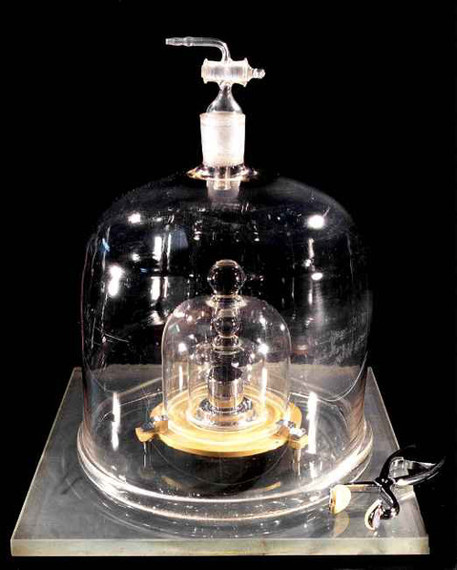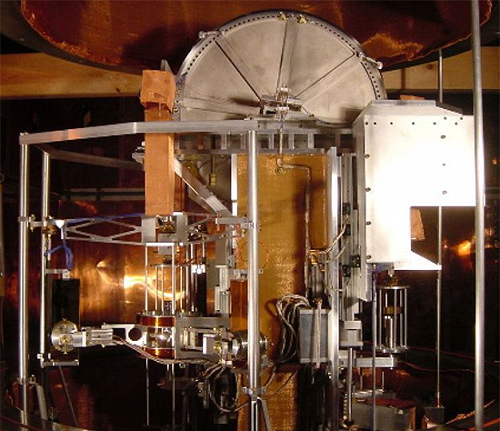
The mass of the Earth is about M = 5.97219 × 10 Kg. The mass of the Sun is M = (1.98855 ± 0.00025) × 10 kg. The unit that we use to measure these masses is the kilogram, determined from a block of platinum and iridium, that celebrated its 125th anniversary last year. That famous block (Figure 1) resides at the International Bureau of Weights and Measures in Sèvres, near Paris. Created in 1889, it is kept in a vault which requires three keys to open (only two of which are in France). There are six official copies of the kilogram that are checked against the original at fixed intervals. There are also about a hundred daughter-blocks around the world, and those are being calibrated in France against the original every few decades.

Figure 1. The international prototype of the kilogram.
In recent years, those calibrations have revealed a disturbing discrepancy -- the parent block appeared to increase in mass (compared to its daughters) by about one part in sixty billionths! The cause for this change is not entirely clear (it may have to do with substances used to clean the block), but the variation has accelerated the plans to replace the actual block of mass by a standard that depends on physical constants.
There is a huge advantage to a definition that is based on constants of nature, over one that employs a particular block of mass.
Imagine, conceptually, that you want to accurately convey to an extrasolar civilization the mass of a certain object. If your definition is based on a platinum-iridium block, you would have to physically transport the block to them. On the other hand, if it is based on physical constants and the laws of nature -- which, as far as we know, are universal -- they can simply measure quantities in their laboratory.
At a meeting on weights and measures last November, the international community decided to adopt in 2018 a new definition of the kilogram, one that is based on the Planck constant h -- the basic quantity of quantum mechanics (the theory of the subatomic world and light).
The equation that will define the new kilogram is based on the product of h with an extremely well-measured frequency (from the atomic element cesium), and that divided by the square of the speed of light (using Einstein's famous equation E = mc).
In order for the new definition to be adopted in 2018, independent labs around the world are currently making measurements to an unprecedented precision, and their results have to agree to within 20 parts per billion. I visited one of these labs, at the National Institute of Standards and Technology (NIST) in Gaithersburg, Maryland, a few weeks ago. It was fascinating to see the "Watt balance" that they will be using for the measurements (Figure 2).

Figure 2. The Watt balance at the National Institute of Standards and Technology in Gaithersburg, Maryland. (Photo by Richard Steiner.)
The kilogram is the last unit that is currently being determined by a physical object as a standard. The change in 2018 will not mean much to most of us, but redefining the kilogram in terms of physical constants means that it is not likely to change again anytime soon.